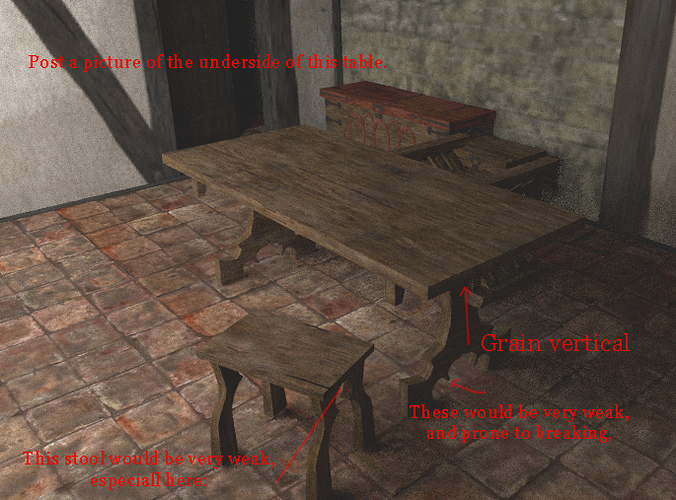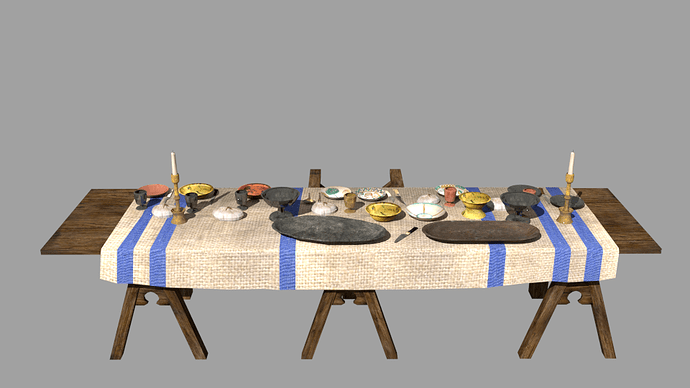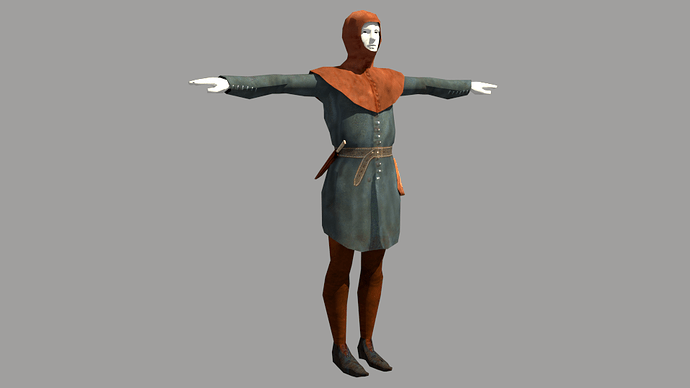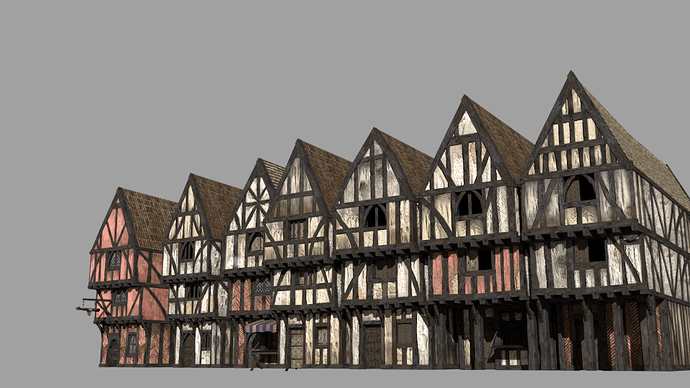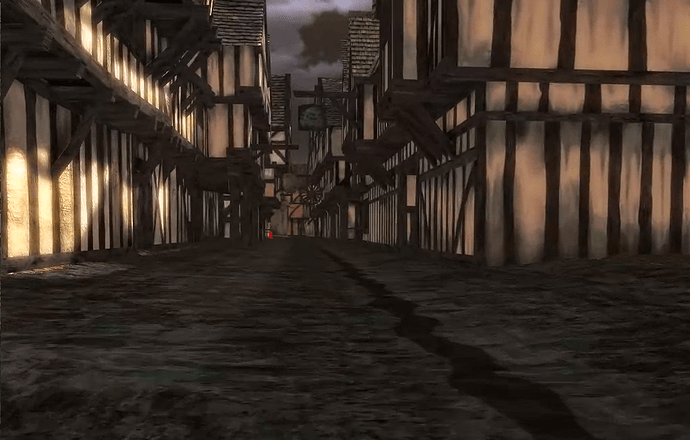I tried this simple method of outlining the boards on Medieval chests, to show you how they were constructed. Arrows indicate grain direction. Your chests have single boards across the fronts and sides, with no indication of joinery at the corners, or the method of construction with multiple boards, which is very understandable, as you are not a furniture maker. It is important to note that many methods for creating Medieval chests were technically wrong - we would not make them like they did today. This is because of the need to allow wood to expand and contract along it’s width, a concept Medieval builders did not understand. Also, in my research, I’ve found a few fairly common methods of making chests, which I’ve show. There are a few others, but for now this is fine. Afteralll, the project isn’t about chests. You just want the details right. I hope this helps! I’m going to do some draw-overs on some of your other pieces now (waiting for glue to dry in the shop).
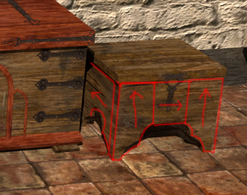
The middle section of this cabinet would usually be longer. If it is to be small, make the bottoms of the side pieces (arrows on the sides) less detailed on the bottom. The legs would break.
Merchant’s counter (main office) and Dining Table (Hall) - followed tons of images of banquets and feasts before getting the disposition of plates and cutlery right. (Doug, I turned the grains, this is still the old render!)
Attachments
Amaizing, what one can learn about past times in this thread. Outstanding work by the way.
Thanks. That is indeed the purpose of the whole thing… To teach history through (3d) images. here is a town dweller I created today.
Attachments
3 town dwellers so far. These outfits were popular in the second half of the XIV century. Spot the rich merchant
Attachments
Tee hee. Looking great!
By the way, I’ve been considering a switch to texture based timber framed house walls - timber and wattle / daub (plaster) in one texture. Only the occasional 3d beam. Why? The wattle plaster is supposed to be flush with the timber framing anyway. I could also really speed up my work flow. I tend to make really complex, many layered materials, and it takes me forever to finish the smallest building. I’ve been thinking about an everything in one material / texture for a while now, with the exception of the windows and doors and stone parts of course. My goal is to move more quickly, and have fewer materials per model. Just thinking out loud here. I’m super inspired by your project, and I’m pretty jealous actually, that you’ve got so much done. I get so obsessed with tiny details that I have trouble getting large projects done. I will of course share my experiment with you when I get it done.
Thanks, and that’s actually what I do. First of all, we created a big texture (4096 x 4096) in PS with all the various timber walls and timber textures, and now am combining them. In this way, I get tons of different houses done in no time, and can model 3d beams when and where I need them. I am obsessed by details too, and that’s good, since I have always thought that details, along with more general things, highlight a good work. Can’t wait to see your stuff as I found it really inspiring in the first place 
I’ve changed direction again…I found a picture I want to emulate the textures of. But I also like the huge resolution of tiling textures. Whenever I make a flat sheet of textures as I described, I hate the fact that the resolution is low. So, I’m making a quick set of beams which will interlock easily, pre-unwrapped and textured. Also, some prefab wall sections, and common elements. So, easier to make bigger wall sections with variety by snapping parts together. Maybe. We will see. I struggle with those details…But you are probably right. One big texture with a bunch of common elements. Arghhhh…I have this idea to create the ultimate low-poly timber framed house.
This is what I’m going for, but in real time, with tileable textures. This is THE PERFECT tudor style house in my opinion, at least for my style. All broken, old, aged etc. Love it. From CG textures.
Had seen it - very beautiful indeed! Anyway, these townhouses are all mapped with the same big texture, and although the quality is not extremely high (also, I’m using a texture reduced by 50% cause my laptop cannot handle the 4096x4096 in blender), it does fairly well in a real time player.
Attachments
Would you email me your texture sheet, just out of curiosity? Looks very good. I want to see how you arranged so many variations.
Another thing is that it’s very difficult to model all those imperfections of the beams and staying low poly at the same time. I create those irregular beams in PS, and then apply a bump map. Also, in many cases, I have seen plaster often ‘invading’ the beams, so that there was no real gap between timber frame and in-filled panels.
Check Facebook. am sending it. it is a constant WIP tho, as we add and remove things
Hey guys 
just a word about details obsession  for my own part i’m also obsessed with Manorial details obsessions
for my own part i’m also obsessed with Manorial details obsessions  lol
lol
What i mean is that when modeling for a realtime target, aimed at running on low-end commercial machines, detail is someting that must be delt with extremely carefully. Of course it’s always good to enhance details, but all got to know at wich price.
In blender render it’s almost not a problem at all. just make 100+ 4Kx4K texture and map your 2billion face model. Just hit F12 and tomorrow you get the most beautifull pic. In RT, you have to smash down face count. wich means that texture resolution should
raise, allowing to add map details for compensating the details loss in mesh. But this often is not possible, as for RT, you’re limited
by 3D card memory 512Mb or 1Gb and by heavy material context swap for each texture that must be achieved several times per seconds…
So what i’d say from my experience ( and that’s sometimes our long discussion trial with Manorial  ) is that it’s useless to make
) is that it’s useless to make
details nobody except you will notice. It’s a hard critic to do on one’s own work but it’s a must do if the deal is for RT.
All this depends of course what you want to show. If you want to show timber in a close-up, yes, model it accurately, but if you want to show a timbered house, don’t bother modeling bug holes. People won’t see them just because they don’t care about them when watching a timbered house 
Also, an important material enhancement can be achieved ( even if it’s not totally realistic ) when using bumpmaps. In unity i made
totally fake and errorfull bumps. When you know how the things react to the light, it’s just totally absurd. However it adds an obvious visual enhancement ! Just because the observer it not here to criticise the bump map into the application. He’s there to have a free walk in a mediaval virtual reality 
Nevertheless, i’m somewhat ashamed of this bumpmap and i’ll have to rework it in it’s whole. But for the moment, it does it’s effect.
At last but not least, 3Dmedieval, and about your latest pic. Yes this can be done through the use of textures with clean plaster, dirt, timber, daub etc… and a modulation texture ( like the one you can use for example for lightmapping ). This can be achieved in blender through the write of a shader ( with nodes ) just like in unity. This way you can ‘paint’ the cracks and defects in the wall just like you would do it in a terrain with multiple texture maps. However, this is pretty heavy for a low end 3D board to run un realtime. Unity formerly made an awesome thing called ‘substance’ and you could apply an ‘aging’ parameter ( and some few more ) to your model. It was really awesome but hardly ran on small configs…
As a conclusion, i’d say, that your perfect model will never exist  you’ll never be totally glad of what you do and will always want to change/enhance this or that, even if it’s not the purpose. The main thing to aim is that people who did not participate to the project see it and say it’s awesome
you’ll never be totally glad of what you do and will always want to change/enhance this or that, even if it’s not the purpose. The main thing to aim is that people who did not participate to the project see it and say it’s awesome 
Happy blending to all 
Did that really come from a Frenchman? 
Haha, thanks Cyrill for the long comment. Indeed, details are something I love, but in the case of a medieval town they will have to be left out, at least some of them. And that makes me sad. Nevertheless, what we are doing here is something new, a sort of medieval encyclopaedia, which covers everything from urban architecture to trade, clothes and food.
And it’s all fully explorable! So it will be a lot of fun. In the meanwhile, we are having a lot of fun creating it. Feeling like deities, but I guess that’s the feeling everybody using blender and other 3d graphics programmes has. Here’s a new screenshot of the High Street. Enjoy 
PS the attention for details is anyway taken in consideration where applicable, i.e. on furniture - thus I must thank you, Doug, again, for all the very useful tips you always give me. Although probably still imperfect, because of me, at least, thanks to you, if some other medieval furniture geeks happen to take a walk in the town they will be pleased with what they see, or at least that’s the goal of the project!
Attachments
Looking very nice. I read your whole comment, and I agree. No details unless they are necessary. RT is like watching a play - the backs of all the props on stage are just empty, plywood etc. Unfinished. Thus it must be with real-time.
I’ve realized something about myself in the last few weeks, while talking to you and working on developing my “perfect” method. I think that’s what I’m passionate about - pushing the bounds of what can be done in real time, within reasonable limits. I enjoy building complex materials and shaders. But in the end, all of my shaders and materials can be dropped down to low rez maps, with just a diffuse and normal map. Those are the first two texture channels I use, and often the only. Anyon who buys or uses one of my models can dump all but those first two, and lower the texture rez. I make models basically to sell on Turbosquid, and I make on average $200 per month, very consistently. People buy models because they look good, so recently I’ve been allowing myself to sell a model with 2048px maps, and a set of 512px maps. Flexible I think.
However, concerning details, technology has come a long way. A typical outdoor scene in Skyrim has tens, if not hundreds of thousands of faces, and a lot of textures (no guess here). But Skyrim is a game, played by people who dump money on graphics cards and memory. Yours is a history simulation, designed to educate and inform, so it should be “playable” on lower end systems.
Know your audience. There is a place for high detail, real-time graphics, and a place for user friendly, lower rez graphics,

